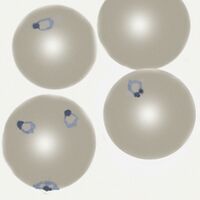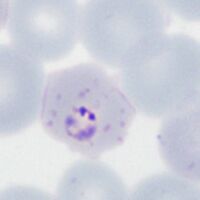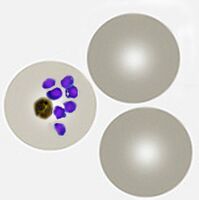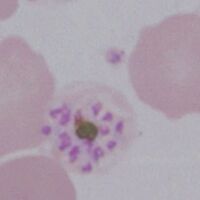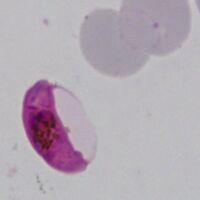Plasmodium falciparum: Morphology: Difference between revisions
From haematologyetc.co.uk
No edit summary |
No edit summary |
||
| Line 61: | Line 61: | ||
<div style="width: 350px"> | |||
{| class="wikitable" style="border-left:solid 4px navy;border-right:solid 4px navy;border-top:solid 4px navy;border-bottom:solid 4px navy; font-size:90%; color:navy; align:center" | |||
| colspan="1"''|[[P.falciparum late trophozoites gallery|Click for ''P.falciparum'' late trophozoite gallery]]'' | |||
|} | |||
</div> | |||
---- | ---- | ||
Revision as of 13:35, 20 March 2024
Navigation
(click blue highlighted text to return to page)
Malaria main index
>Species identification: summary page
>>This page: P.falciparum: morphology
| The early trophozoite |
The earliest growth stage, and may be the only form seen in this species:
- Ring forms that are fine and delicate
- Frequently the red cells contain multiple parasites
- Parasites may have a distinctive double chromatin dot (signet ring form)
- Parasites may appear on the edge of the red cell and have a flattened appearance (accolé forms)
- Affected red cells have normal size and haemoglobin content
| The late trophozoite |
The later growth stage:
- Parasites resemble early ring forms, but are thicker and may be slightly larger
- Additional blue/grey dots and clefts are seen in cytoplasm when stained correctly
- These added dots have a characteristic appearance Maurer's dots and clefts
- Size and shape of infected red cells is usually unaffected, but red cells may become crenated
- Typical double chromatin dot, accolé forms, and multiple parasites/cell remain present
| The schizont |
The asexual form:
- Do not generally circulate in this species unless overwhelming infection
- Contain multiple asexually formed developing parasites (most frequently 8-16)
- Development is progressive: first there are multiple chromatin dots, later a distinct nucleus and cytoplasm appears
- Loose pigment may be seen in clumps between the parasites
- Red cell size is generally unaffected but haemoglobin will largely be absent (metabolised by the parasites)
The gametocyte
| The gametocyte |
The sexual replication form (very distinctive).
- Gametocytes are elongated but are restricted into typical shape by the red cell membrane
- They parasites are rod shaped but the membrane may cause them to curve into a “"banana" form”
- The residual membrane (empty of haemoglobin) is often seen as a "blister" to the side of the parasite
- The single chromatin area is in the centre of the parasite, often has pigment overlying it
- Gametocytes may not be be seen, or may be the only form present (particularly after treatment)
